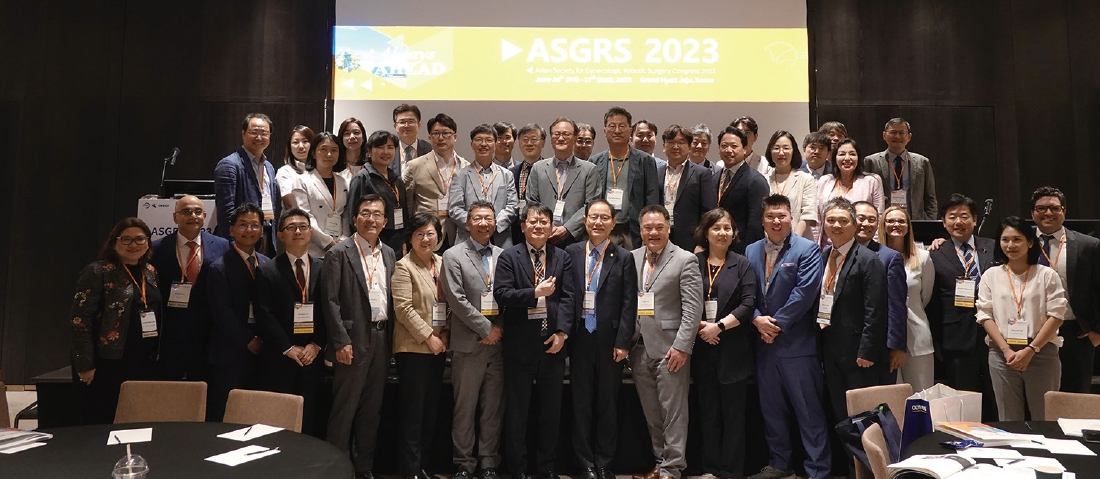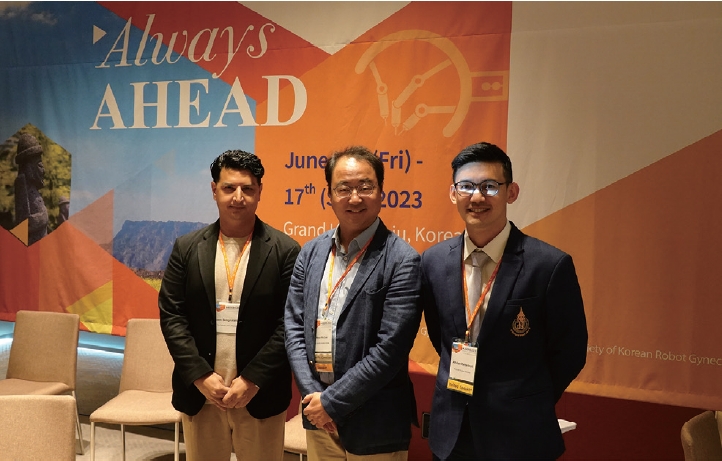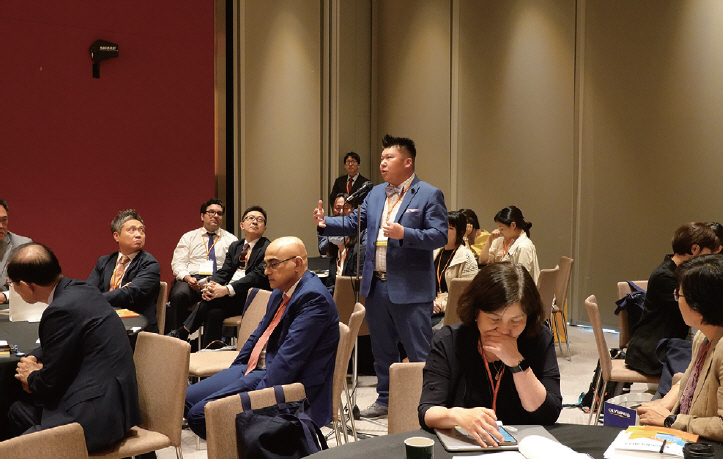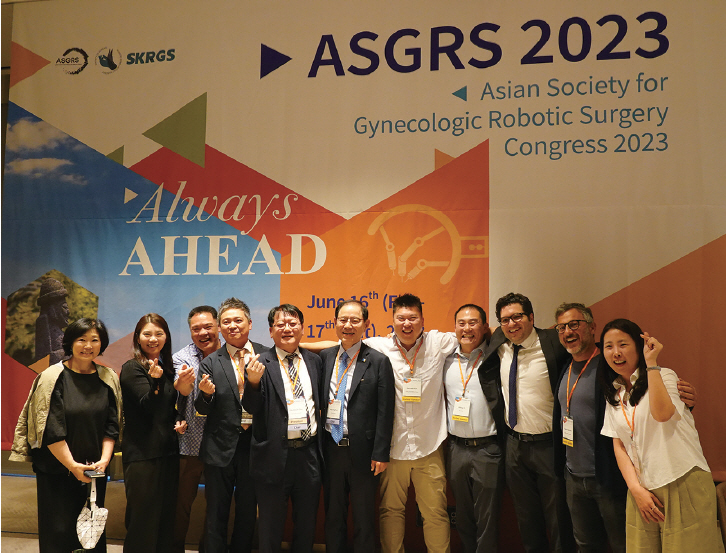Asian Society for Gynecologic Robotic Surgery Congress 2023, Always AHEAD
Article information
The Asian Society for Gynecologic Robotic Surgery Congress 2023 (ASGRS 2023) was held at the Grand Hyatt, Jeju Island, Korea, from Friday, June 16 to Saturday, June 17, 2023. After a great success of the hybrid meeting/online ASGRS congress in 2022, ASGRS 2023 was the first face-to-face international congress held in Asia in a long time after COVID-19, as well as being it is the only international stand-alone robotic/Minimally Invasive Surgery gynecology meeting for robotic gynecology surgeons in Asia. Under the theme, Always AHEAD, many surgeons from over 10 different countries participated enthusiastically (Fig. 1). This 2 days’ congress consisted of five sessions, three key lectures, and a satellite symposium for nurses and physician assistants.

AInvited speakers and modulators of the Asian Society for Gynecologic Robotic Surgery Congress 2023.
FRIDAY, JUNE 16
The topic for the first session was “Robotic SP Surgery: from A to Z”. Three well-known professors from Korea, Sa Ra Lee, Dae Gy Hong, and Jae-Yun Song, gave lectures on robotic SP surgery which is the latest version of robotic surgery with a system designed for single-port access. This session was full of worthy advices which are helpful to beginner surgeons who would like to try on robotic SP surgery.
The topic for the first key lecture was “Updates on Robotic Surgery in Gynecologic (GYN) Cancers.” Emma Rossi (USA) talked about robotic sentinel lymph node (LN) mapping in GYN cancer and Dae-Yeon Kim (Korea) talked about robotic radical hysterectomy. They emphasized that if strengths of robot-assisted surgery are reinforced with efforts to improve survival outcomes of minimally invasive surgery, survival outcomes may be comparable to open surgery. The topic of the second key lecture was “Updates on Robotic Surgery in GYN Benign Diseases.” Xiaoming Guan (USA) explicated thoroughly about robotic Xi for transvaginal NOTE myomectomy as well as the key surgical techniques to provide the best benefit of uterine preservation for future fertility. Johnny Yi (USA) reviewed abdominal approach of pelvic reconstruction and described techniques for single port approach and limitations. Dean Conrad (Australia) talked about robotic burch colposuspension for stress urinary incontinence.
The second session was about “Beyond Robotics, the Future of Computer Assisted Surgery.” Rooma Sinha demonstrated three-dimensional (3D) printing for robotic myomectomy (Fig. 2). Seong Min Kim (Korea) presented the state of the art of robotically assisted surgical systems and gave a general idea about how technology can assist in robotic surgery today and in the future. Jiangtao Fan (China) introduced platform innovation for robotic surgery in China. Surprisingly, there are 5 new brand domestic robotic platforms emerging in China within the last 3–5years. Hiroaki Kobayashi (Japan) presented HinotoriTM, the first surgical robotic system made in Japan. The Japanese word ‘honotori’ means the fire bird indicating the phoenix. He stated that the performance of the hinotori seems to be equivalent to the da Vinci surgical systems except several points originated from differences. Venkatesh Munnikrishnan (India) shared his first experience with HUGO system: comparison with the da Vinci.

Rooma Sinha, Apollo Hospitals Jubilee Hills, India presenting 3D printing for robotic myomectomy online. 3D, three-dimensional.
The third session: “The Student Has Become the Master! caught many people's attention.” The international fellows who had chances to learn in Korea as a clinical fellow shared their experiences in Korea and their home country. Athian Rattanburi (Thailand) worked with professor Keun Ho Lee (Korea) at the Catholic University of Korea, Seoul St. Mary’s Hospital, Seoul, Korea (Fig. 3). Chun-Hui Wei (Taiwan) worked with professor Tae Joong Kim at Samsung Medical Center in Seoul, Korea focusing on single incision laparoscopic surgery and Robotic Surgery.
SATURDAY, JUNE 17
The Day 2 start with session 4, “Single-Port Battle: LESS vs RSS vs SP myomectomy (fibroid: 7–8cm, anterior wall, IM type, solitary).” Yong Wook Jung (Korea) showed examples of laparoscopic myomectomy using single port platform as well as barbed suture simplified suturing. So-jin Shin (Korea) presented tips and tricks to performing a successful robotic single site myomectomy. Youn Jee Jung (Korea) shared her experience and insight about robotic SP myomectomy.
The session 5 was about Best-In-Class Robotic Performance in GYN cancers. Jeong-Yeol Park (Korea) showed step-by-step procedures for robotic radical hysterectomy using safety maneuver to achieve optimal surgical and oncologic outcomes. Adrian Kim (Korea) presented procedure of robot-assisted pelvic exenteration with surgical precautions. Dongling Zou (China) shared her opinions on robotic salvage hysterectomy for persistent cervical cancer after concurrent chemoradiation therapy. Sang Wun Kim (Korea) talked about robotic paraaortic sentinel LN mapping with Da Vinci SP system. Ka Yu Tse (Hong Kong) explained about robotic upper paraaortic lymph node dissection (PALND). She stated that robotic PALND is safe, learning curve is not too long, and port replacement is the key to success.
The key lecture on Day 2 was about “Is There any Royal Road for Robotic GYN Surgery?” Peter Lim (USA) talked about robotic approach for primary cytoreductive surgery in ovarian cancer. In his experience, robotic primary cytoreductive surgery for advance staged ovarian cancer is achievable, feasible and associated with decreased blood loss, complications and hospitalizations. Valerio Gallotta (Italy) gave a lecture on the role of robotic surgery in recurrent GYN cancers. He stated that it is conceivable that in the future, larger numbers of patients will benefit from minimally secondary cytoreductive surgery due to a more accurate assessment of disease extension and a wider diffusion of robotic/laparoscopic approaches in patients with recurrent disease, even for tertiary cytoreduction. Kenneth Kim (USA) presented machine learning and AI in robotic surgery and training (Fig. 4). He shared various ideas to make better surgery with emerging and evolving digital tools and technologies. He also emphasized that we need to build out a robust ecosystem of tools, technologies and training programs to facilitate capabilities using Surgical Data Science. And there was a satellite symposium for nurses and physical assistants which was very motivating and enlightening experience.
ASGRS 2023 is the only congress where you can share the latest research results and keep up with the latest surgical flow in robotic gynecology. In this meeting you not only learn, but communicate and recharge yourself in your expertise. ASGRS keeps growing with more surgeons participating from many different countries worldwide (Fig. 5). On behalf of ASGRS I would like to thank your support and love. See you next year.
Notes
Conflict of interest
No potential conflict of interest relevant to this article was reported.


